Journal of Aeronautics & Aerospace Engineering
Open Access
ISSN: 2168-9792
+44-77-2385-9429
ISSN: 2168-9792
+44-77-2385-9429
Research - (2020)Volume 9, Issue 1
This article presents a review of current aircraft noises and technologies to reduce noise as well as an estimate of the technology’s readiness level. Aircraft noise remains the key inhibitor of the growth of air transportation and remains an acute environmental problem that requires advanced solutions. To deal with this problem, aircraft manufacturers and public establishments are engaged in research on technical and theoretical approaches for noise reduction concepts that should be applied to new aircraft. This review paper discusses a selection of enabling technologies and their implications on acoustics and noise and gives a perspective on future trends and new directions in aeroacoustics required to address the challenges.
Noise reduction; Aircraft noise; Technology trends; Aeroacoustics; Sound propagation
ANC: Active Noise Control; DLR: Deutsches Luft- Raumfahrt; AWB: Aeroacoustics Wind Tunnel Brauschweig; HLD: High Lift Device; RAIN: Airframe and Installation Noise; HBR: High Bypass Ratio; UHBR: Ultra High Bypass Ratio; DDTF: Direct Drive TurboFan; CRTF: Counter-Rotating Turbo Fan; GTF: Geared TurboFan; RESOUND: Reduction of Engine Source Noise through Understanding and Novel Design; OR: Open Rotor
Jet engine noise suppression has become one of the most important fields of research due to airport regulations and aircraft noise certification requirements. Further reductions in aircraft noise will be harder to achieve, and the problem becomes more difficult with anticipated increases in noise due to increased aircraft operations. It has been the implementation of innovative technology solutions related to engine and shape design that have resulted in the noise reductions. When an aircraft gets to fly it produces friction and turbulence that causes sound waves. In general, as the faster flight of the aircraft becomes more turbulent and friction will occurs. As long as the flaps and landing gear of aircraft are used, more noise is created because more drag is being generated. The quantity of noise which is generated can be different according to the way the plane is flying.
The elimination of aircraft noises is the long-term goals of the industry, universities and government agencies. The noise generated by the airframe is a factor of several parameters affecting the noise level of aircraft; the main source of noise is in the engine. In general way noise reduction techniques can be arranged into passive and active methods. Passive control involves reducing the radiated noise by energy absorption, while the active method involves reducing the source strength or manipulating the acoustic field in the duct to get noise reduction.
There are significant sources of noise in the fan or compressor, turbine and jet or exhaust jets. The noise generation of these components increases with the relative velocity of the airflow. The exhaust jet noise has the significant part of the noise in comparison with compressor or turbine, so reducing it has a profound effect than a similar reduction in above mentioned. Jet exhaust noise is generated when a mixture of produced gases with a turbulent cases are being released that also being affected by the shearing action due to the relative velocity between the exhaust jet and the atmosphere.
The turbulence which is generated near the exhaust exit is the reason of high frequency noise (small eddies) and more at the lower exhaust, turbulence makes low frequency noise (large eddies) also, a shock wave is created as the exhaust velocity exceed the velocity of sound. Reducing noise could be achieved when the rate of mixing getting faster or the relative velocity exhaust to the atmosphere decreases. The noise of the compressor and the turbine is due to the interaction of pressure and turbulence fields for rotary blades and fixed vanes. In the jet engine, the exhaust jet noise is of a high level that the turbine and compressor noise is negligible in most operating conditions. However, low landing gears reduce exhaust jet noise and low pressure compressor and turbine noise will be increased for the cause of internal power.
Another source of noise is the combustion chamber which is located inside the engine. However, due to being buried in the engine core, it does not have dominated influence. Progress in noise reduction technology such as smooth acoustically inlet and chevrons has made these improved engines available on existing aircraft, and at the same time meeting challenging the requirements for noise. Looking for the future, it is unclear whether the process of increasing productivity will generally continue with decreasing fuel consumption and reducing community noise.
The primary aim of the present paper is to provide a review on the main noises of aircrafts and theologies to reducing them. Emphasis is placed on evolution of these technologies that are widely used by the major aerospace research establishments.
Types of noises
Airframe noise: In the early 1970s Research into airframe noise reduction and prediction was started. This investigation was done by Crighton [1]. Crighton defined airframe noise as the nonpropulsive noise of an aircraft in flight and includes the noise of a glider. The empirical data recorded on aircraft noise assisted in the formulation of an experimental airframe noise prediction method published by Fink [2]. Airframe noise is defined as the noise generated as a result of the airframe moving through the air. The main components of airframe that lead to airframe noise generation are high lift devices and landing gears. In 1970s some initial airframe noise studies were carried out, and reference provides a good summary of this airframe noise research work [3,4]. During the 198Os, a lack of funding for research on airframe noise caused the technology to remain at the 1970s level. In the 199Os, research about an airframe noise has been kept on again in the USA where analytical and experimental works were conducted effort between NASA and the aircraft industry. Noise testing was performed on scaled aircraft models and adequate noise localization techniques were developed [5,6].
An airframe noise occurs when air passes over the plane’s body and it wings. This cusses friction and turbulence, and make noise. Even gliders make a noise when in flight and they have no engines at all. Planes land with their flaps down and their landing gear deployed. This creates more friction, and produces more noise, than when the flaps are up and the landing gear is stowed.
The aerodynamic noise which is created by all the non-propulsive components of an aircraft is classified as airframe noise. For advanced high-bypass engine powered commercial aircraft, the airframe noise has the major role in the overall amount of flight noise levels during landing approach stages, when the highlift devices and the landing-gear are ready to be used. Five main mechanisms are known to significantly contribute airframe noise: (i) the landing-gear multi-scale vortex dynamics and the consequent multi-frequency unsteady force applied to the gear components, (ii) the flow unsteadiness in the recirculation bubble behind the slat leading-edge, (iii) the vortex shedding from slat/main-body trailingedges and the possible gap tone excitation through nonlinear coupling in the slat/flap coves, (iv) the roll-up vortex at the flap side edge, (v) the wing trailing-edge scattering of boundary-layer turbulent kinetic energy into acoustic energy. Since the Seventies most of these mechanisms have been addressed both empirically and theoretically.
Aerodynamic noise which is created from airframe components identified as a most important contributor to commercial aircraft noise emissions. The intense regulatory context governing civil aviation has caused of research in optimize of noise generated by airframe and other aircraft components in large amount. Adaptive techniques and Flow control are two possible solutions for noise reduction, when other methods are not effective. Such unconventional techniques include boundary layer excitation, exploitation of cavity resonance effects and flow distortion in airframe components.
It was triggered by this US initiative and the intended extension of a very large aircraft; in 1995 Airbus industry was volunteer for sponsoring two airframe noise related research projects. These include the full scale noise testing of the landing gears and scaled aircraft model high lift devices in wind tunnel [7,8].
Dobrzynski W, et al. In 1998 worked in results of initial and basic experiments conducted on a model scale high-lift wing-section in DLR’s AWB provided detailed information on source noise characteristics, led to a better understanding of the dominating mechanisms on slats or flaps and revealed perspectives for noise reduction [9].
Werner Dobrzynski, et al. in 2001, Since airframe noise has become a significant contributor to the overall radiated noise from commercial aircraft during landing approach, a research project was initiated to investigate the noise of wing HLD, known to represent one major source of airframe noise. Noise source studies where performed on both a 1/7.5 scaled complete model and an A320 full scale wing section, employing far field microphones and source localization techniques, to quantify airframe noise levels and identify the major aero acoustic sources. Potential source areas were instrumented with unsteady pressure sensors to study local source characteristics in detail [10].
In 1999 Leung Choi Cho and Pierre Lempereurn announced a brief description of research project which took them for three years, ‘reduction of airframe and installation noise (RAIN) [11] (Figure 1).
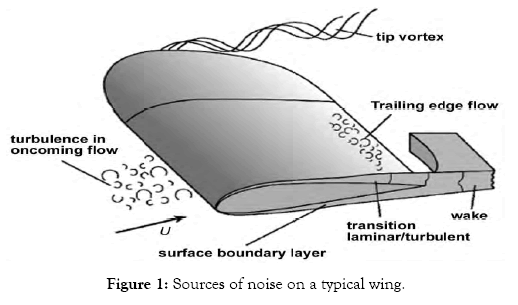
Figure 1: Sources of noise on a typical wing.
Fan noise: Reduction of fan noise radiation to the far field can be followed by five general concepts: (i) reducing the interaction mechanisms between an optimal design of the rotor blades and the stator vanes, or to reduces the velocity deficit in the rotor wakes with the flow control techniques, (ii) reduce the aerodynamic response to an impinging gust by tuning of the stator cascade parameters in order to, (iii) to drive only few propagating (cut-on) duct modes by tuning of the rotor blades and stator vanes numbers, (iv) use of passive/active duct wall treatments in order to reduce noise during transmitting from the duct, (v) manipulation of sound diffraction mechanism in exhaust nozzle and at the inlet lip through advanced nacelle devices. Since the first two noise mitigation concepts requires analytical models that highlight the mutual influence of all the design parameters.
In turbofan aero-engines, noise is created by the interaction between flow non-uniformities and stator vanes and rotating bladed. In modern high-bypass-ratio turbofans, the noise generated by the fan system has the main role than the one generated by the turbine stages and the compressor. Since there is connection between the duct acoustic modes and aero acoustic excitation mechanisms.
Through the duct under the condition, at supersonic blade tip, the rotor-locked shock wave system makes propagative several pure tones at rotational shaft harmonics frequency, the so called “buzzsaw” noise.
Fan noise is a powerful performance of the fan pressure ratio and rotational tip speed. The reliable approach to reduce fan noise is to mitigate the pressure ratio and tip speed, but this will increase the engine diameter to recover thrust. Optimization examinations demonstrate that the best fan speed for takeoff is where the rotational tip speed is just below Mach=1 to eradicate shock induced noise. After achieving this engine design; the fan pressure ratio becomes the controlling factor for broadband noise. Reducing pressure ratio and fan tip speed, reduce the number of noise sources, which makes noise reduction design features more effective [12]. European Brite-Euram project called RESOUND (Reduction of Engine Source Noise through Understanding and Novel Design) was launched in 1998. A task of this project was dedicated to laboratory experiments relative to passive/active design [13].
Currently active noise control approach (ANC) that has been studied by many authors [14-20]. The use of the well-known concept of noise reduction in fan noise involves of attempting to cancel the interaction modes by generating the identical out-ofphase spinning modes. Typical ANC studies are generally based on two possibilities: (1) as active sources use of flush-mounted loudspeakers; (2) the active source is an airfoil equipped with actuators (active airfoil). Using a sophisticated experimental setup shows the capability of these ANC techniques to the noise reduction. Unfortunately, because of weight, applications to turbofans are not straightforward, complexity of such devices and aerodynamic penalties (Figure 2).
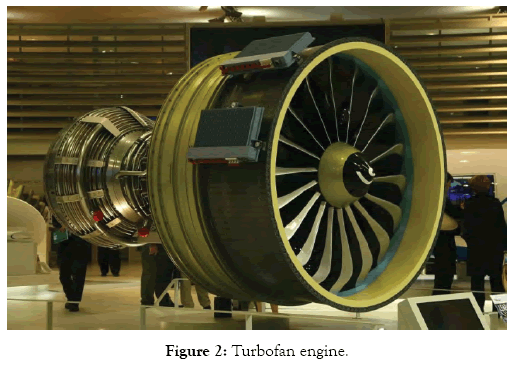
Figure 2: Turbofan engine.
Flap noise: It’s too long that flap side edge flows have been recognized as important factor in airframe noise. Vertical flow around the side edge of a deployed flap is one of the most effective sources of airframe noise at landing and takeoff conditions. Additionally, vortex breakdown at high flap angles is observed as an additional noise source mechanism.
The noise source mechanisms are the cause of the vortex structure of the cross flows in the flap side edge region [21-25]. This concept has caused the concepts for noise mitigation like flap side edge fences, seeking to reform the properties of the vortex structure in a desirable approach to reduce the noise from these currents. While there are difficulties in the use of this concept in real aircraft, such as the cost and added weight, its effectiveness in reducing noise –associated with flap has been shown to be very clear [26-28]. These successful demonstrations include both simplified flaps and realistic aircraft configurations. Typically, side edge fences can reduce noise by up to 4 dB in the middle to high frequency domain in which flaps are known to be major noise sources.
It has been proved in wind tunnel experiments that the fences only alter the local flows in that the overall lift characteristics of the flaps and the high lift systems is not influenced by the fences in any significant way [27]. The vortex structure in the cross flow will be appeared in the surface pressures in the form of distinct spectral humps [29]. In 2003 Yueping Guo shows that reduction of flap-related noise by shifting the source spectra downward in frequency can be achieved. Analytical prediction for the frequency change has been given and has been shown to agree with data quite satisfactorily. It should be noted that with the weakness of the source current, fences might also reduce noise [30] (Figure 3).
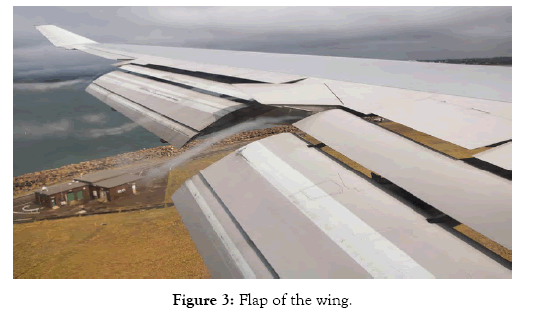
Figure 3: Flap of the wing.
Jet noise: Mixing of the high-velocity exhaust stream with the still air causes Jet noise, which causes friction. When these two Streams at different velocities are mixed, significant amount of turbulence is created, with the intensity of the turbulence, and hence the noise increases as eighth power of the velocity difference [31-33]. Modern bypass engines, which introduce a layer of moderately fastmoving cold air between the hot exhaust and the ambient air, are quieter than early jet engines, which didn’t use this technology.
Engine noise is created by the sound from the moving parts of the engine and by the air coming out of the engine at high speed and interacting with still air, creating friction. Most of the engine noise comes from the exhaust or jet behind the engine as it mixes with the air around it. Modern bypass engines introduce a layer of moderately fast-moving cold air between the hot exhaust and the still air. This makes them quitter than the engines on earlier jets, which didn’t use the bypass technology.
The degree to which people experience aircraft noise on the ground has a lot of do with atmospheric condition. Temperature wind speed and direction, humidity, rain, cloud cover all have a part to play. The reverberation of sound waves caused by the weather can make noises seem louder. Sometime the aircraft flying at the altitudes that would not normally produce noise may be heard in certain atmospheric condition. The noise that coming from airplane is caused by two things: from air going over its body (or ‘airframe’) and from its engines.
Over the years there was considerable decrease in Jet noise, mainly because of an increase in (BPR) in turbofan engines, which reduces the velocity gradient therefore, the shear stresses within the shear layer of exhausted jets. In modern high-BPR engines, an increase in the nacelle diameter has caused the aircraft to operate by reducing exhaust flow velocities without affecting the thrust. The engine exhaust velocity has to decrease in order to reduce the engine noise during takeoff. The exhaust nozzle is designed to have variable area in order to ensure fan operability at the low power, with cruise bypass ratio of 12 and take-off bypass ratio of 18. The low engine rotational speed during approach enabled by the variable nozzle mitigates the rearward fan noise and the airframe drag requirements. The fan design, however, must now accommodate the wide range of flows related to the performance of low pressure ratio fans at different flight conditions. A change in fan design methodology was required to enable the fan to cope with the various conditions imposed by the variable area nozzle (Figure 4).
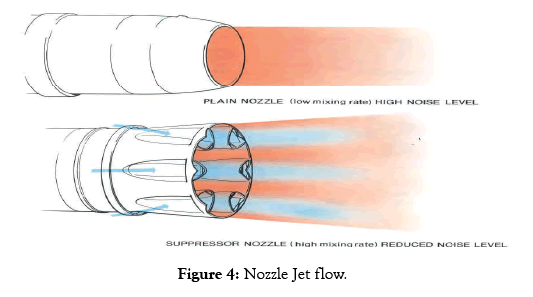
Figure 4: Nozzle Jet flow.
Technologies for noise reduction
Active noise control: Active noise control, also known as active noise cancellation is the reduction of sound wave by adding reverse sound wave. A noise cancelation speaker send out sound with amplitude as same as the noise sources but with inverted phase . waves combine to constitute new wave and effectively cancel each other out. ANC has become more and more popular in recent years. At 1991 J. C. Stevens and K. K. Ahujat in Georgia Institute of Technology, Atlanta, Georgia worked in active noise control. This popularity is due, in part, to the advancement of electronics and signal-processing techniques which take advantage of increased computer power. In particular, adaptive filtering method has natural applications in active noise control [34] (Figure 5).
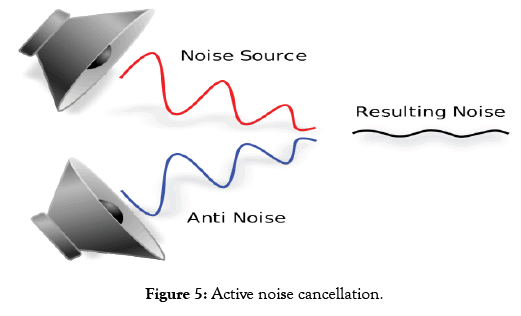
Figure 5: Active noise cancellation.
Acoustic boundary control: An acoustic boundary control method has been developed by Hirsch and Sun that proposes to implement a distributed array of acoustic sources at the structuralacoustic interface in conjunction with a sensor array [35]. Hirsch, Jayachandran and Sun proposed the acoustic boundary control approach for preventing internal sound areas which mixes the lowered power requirements of ANC. A mathematical model of curved composite trim panels has been mentioned in the article [36].
Shape optimization: It has been shown that shape optimization tools can be used effectively to design the inlet duct to reduce the radiated sound in distant area. The main idea of the shape optimization is to minimize the far field acoustic radiation by controlling the geometry of an engine duct.
Novel acoustic treatments and shape design of turbofan engine ducts to attenuate such noise are vital for the noise reduction of modern aircraft engines. These designs usually depend on extensive empirical tests, which are very expensive and time consuming.
In the past, research activities in the field of noise optimization systems have been carried out. It has been shown that in the case of noise reduction of radiated sound in the far field, these shape optimization tools can be effectively used. The controlling the geometry of an engine duct, could be main idea of the shape optimization in order to to minimize the far field acoustic radiation.
Chenais had examined the mathematical aspect of the problem [37]. For the existence of an optimal shape for systems, He mentioned the conditions necessary by coercive elliptic partial differential equations. More recently, there had been research in minimization of viscous through shape modifications in [38]. Extensive research work had been done on shape identification for acoustic scattering problems [39].
Yanzhao Cao in 2002 showed the results that it may present one viable alternative for far field noise reduction. The extension of this work to the case with mean flow represents a natural extension of these results which we hope to address in the near future [40].
Ultra High Bypass Ratio (UHBR)
In 1970 Boeing 747-100, the HBR turbofan engine was entered commercial service; soon, it was followed by McDonnell-Douglas, Lockheed who was other wide-body aircraft, and the newly formed Airbus consortium. A major advance in environmental protection was achieved, because these engines, which were produced by Pratt & Whitney, General Electric, and Rolls-Royce, they consume significantly less fuel. At the front of a turbofan engine there is a massive fan which creates the lion’s share of thrust (up to 80 percent on an ordinary commercial jetliner) and accounts for two airflows: the main flow, that passes through the engine core and be involved in combustion, and the latter flow, which drives the engine core through the nozzle. By increasing this secondary flow, Increase of the BPR (the ratio of the cold airflow to the hot airflow) is achieved. At a given level of thrust, increasing the BPR decreases the exhaust gas speed and therefore the noise it generates. By increasing the BPR to reduce noise, the optimum fan pressure ratio reduces and the specific thrust drops, as a result the optimum fan tip speed also is reduced. A decrease in tip speed with the increased fan diameter together, causes to a drop in shaft speed and an increase in shaft torque.
Noise reduction research has been summarized with participation of DLR which aims to reduce aircraft engine noise at the source, because this is the most effective and economical way to reduce noise. The main part of noise reduction potential can be seen in the Ultra- High Bypass Ratio (UHBR) engine concept where can be observed that the average flow Mach number at the blade tip is reduced. This large reduction in fan rotation speed requires that the fan to be driven by the turbine through a gear box to maintain the high turbine speeds necessary for proper aerodynamic efficiency. It is necessary to large bypass ratios together with much reduced jet velocities for reduction of jet noise down to an acceptable level. With the reduction in jet noise other noise sources become dominant which also need to be reduced to achieve the 10 dB reduction target. Methods of Active noise control have been studied in order to reduce the total fan noise of aircraft engines. There is accomplishment in radiated sound power up to 34 dB with loudspeakers mounted flush with the duct wall impressive tone level. Active stators do not reduce the space available in the nacelle for passive liners; therefore they are a promising concept. Recent laboratory experiment have shown that current flow induced sound sources generated by flow disturbances at the blade tips are another means to avoid the weight and space penalties associated with the conventional loudspeakers. In UHBR engines, the low pressure turbine has the main role of overall noise. In order to fully assess the effectiveness of noise reduction studies involving blade and vane design advanced sound measurement and modal analysis techniques are required [41]. Pascovici in 2008 suggested a model for coupling engine and aircraft performance with noise algorithms of three ultrahigh bypass engines. Various parameters have been examined also a comparison with the baseline engines Trent 772 and CFM56-7b has been done too. The purpose of these analysis, comparison, and calculation, was to determine the viable improvements calculated from a change in cycle just as problems that are related with these new concepts (DDTF, CRTF, and GTF) [42] (Figure 6).
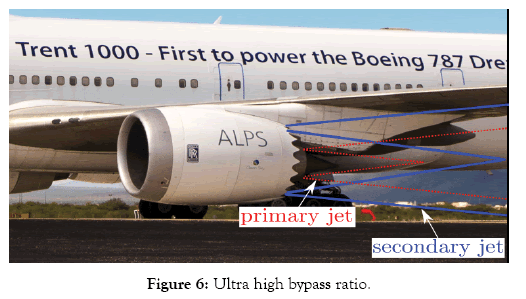
Figure 6: Ultra high bypass ratio.
Duct flow
The fan noise can be reduced effectively by the use of the equipment of an optimally designed acoustic liner in the engine nozzle. To this end, some design challenges must be addressed, including the choice of acoustic liner material and layer structure.
To reduce noise within the turbofan bypass duct, the use of acoustic liners is already common, and it is usual practice to consider the effect of liner configuration as a noise reduction measure. The basic idea of the shape optimization is to minimize the far-field acoustic radiation by controlling the geometry of an engine duct. The embedded propulsion system allows smaller engine diameter and thus increased non-dimensional (length/diameter) duct length. The longer inlet and exit ducts causes engine noise reduction by allowing additional acoustic liners, compared to ordinary nacelles, to absorb the engine noise. Another promising technique for fan noise reduction is to increase the acoustic treatment area on the tip of the rotor. Existing engines only use acoustic liners in fan ducts and the inlet, and sometimes in the inter-stage region. To provide maximum insertion losses around a desired target frequency, they usually use honeycomb materials with porous or felt metal face sheets. NASA has explored that metal foams can be used to provide optimum bulk liner properties which also provide engine requirements over a range of temperatures for either the fan ducts or the core [43] (Figure 7). The concept of active absorption was first put forward by Olson and May who mentioned an electronic sound absorber providing pressure release on the back face of a resistive sheet. In the 1980s, Guicking and Lorenz [44,45] confirmed this concept by experimental. Several researches have sought to implement hybrid absorption technology, leading to patent applications [46]. Thenail and Furstoss [47,48] developed an active treatment consisting of a layer of glass wool layer backed by an air cavity closed through an active surface. Beyene and Burdisso obtained active boundary conditions by using impedance adaptation in a porous rear face layer [49]. More recently; Cobo et al. [50] illustrated the feasibility of designing thinner hybrid passive/active absorbers using micro perforated panels instead of the conventional porous materials.
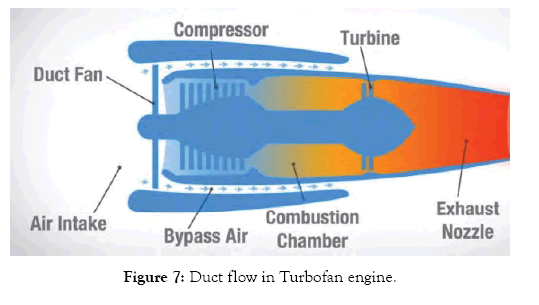
Figure 7: Duct flow in Turbofan engine.
Chevron
Chevron nozzles have drawn a lot of attention recently as they are currently one of the most popular passive jet noise reduction devices. Investigations reveals that, by adding chevrons to the nozzle significant amount of noise reduction will occur. In medium and high bypass turbofan engines, chevron nozzles represent the current state in jet noise reduction technology. These nozzles possess triangular serrations along the trailing edge, which induce stream wise vortices into the shear layer.
Serrating trailing edge geometry, chevron nozzles are the cause of enhancement in mixing between adjacent streams, reducing the velocity gradient across the jet plume. The penetration rate in the individual chevron lobes is lower than that for the tabbed nozzles, and so resulting vortices are weaker.
Compared with other noise mitigation technologies, chevron nozzles are the most effective reducing engine exhaust noise tools, with minimal penalty on engine performance. However chevron nozzle seems to be an interesting solution to the jet noise problem, There is not much empirical work has been done with chevron nozzles. Researches seem to be in computational aero acoustics, because of vastly improved numerical methods based on of very powerful computers. Chevron nozzles are known to be excellent attenuators of jet noise. Conventional chevron nozzles use triangular serrations at the trailing edge of the nozzle. According to Bridges and Brown [51], the chevron count controls the azimuthal spacing between the axial vortices, whereas chevron penetration controls the strength of the axial vortices and chevron length controls the distribution of vortices within axial vortices Bridges and Brown [51] studied the influence of geometrical chevron parameters on flow and noise characteristics and far field on a parametric family of chevron nozzles. A high chevron count resulted in good lowfrequency reductions without considerable high-frequency penalty; Callender et al. [52] empirically examined single and dual flows for baseline inner nozzle and three chevron nozzles over an extended range of operating conditions. Chevrons with different numbers of lobes and levels of penetration were performed to find out the effect of these geometrical parameters on far-field acoustics. Chevron nozzles are the most effective at lower frequencies and at aft directivity angles based on Spectral and directivity results from heated coaxial.
Rask et al. [53] conducted experiments to determine the acoustic emissions from chevron nozzles operating at under-expanded conditions. It has been shown that the chevron nozzle was result in lower shock noise levels by 2.1 dB for the Mach 0.85 condition. It was also found that the chevron nozzle reduced the shock cell spacing, resulting in a higher frequency shock noise.
Callender et al. [54] conducted empirical researches about the effect of chevron nozzles on the near-field acoustics were for a separate flow exhaust system. Chevron count and levels of penetration were different to provide insight into the influences of these parameters on the acoustic near-field.
It was understood that chevrons are effective at low frequencies where the peak noise region was mitigated by 5-7 db. The nozzle penetration was more important than the number of chevron lobes for noise mitigation in the near-field. Khritov et al. [55] presented computational and experimental results containing turbulence and jet noise for baseline nozzles, chevron nozzles, and coaxial nozzles with chevrons. Experiments also showed a weak effect of external flow on the noise level in a coaxial nozzle jet.
Numerical predictions of single-stream chevron nozzle flow and far-field acoustics presented by Engblom, et al. [56]. Birch et al. [57] employed RANS-based jet noise prediction model to a series of chevron nozzle flows and the predictions were compared with experimental data. Chevrons have been shown to affect the flow in two important ways. Massey et al. [58] presented a computational flow field and predicted jet noise source analysis for asymmetrical fan chevrons on a separate flow nozzle at take-off conditions.
Uzun and Hussaini [59] presented the simulation of the near-nozzle region of a moderate Reynolds number cold jet flow exhausting from a chevron nozzle. Simulation of flow through symmetric chevrons with a 5° penetration angle was done, by them. The chevron nozzle flow and the free jet flow outside were simultaneously calculated by a high-order accurate, multi-block, large eddy simulation code with ∼100 million grid points. The enhanced shear layer mixing were captured by the simulation due to the chevrons and the resulting noise generation that happens in the mixing layers of the jet within the first few diameters downstream of the nozzle exit.
Shur et al. [60] reported noise mitigation concepts such as beveled nozzles chevron nozzles, and dual nozzles with enhancement in numerical system to represent complex nozzle flows more faithfully. The simulations were performed on PC clusters on a grid size of 2–4 million nodes with a goal accuracy of 2–3 dB for both directivity and spectrum. However, the limitation in frequency prediction are significant for chevron nozzles, they showed that exiting computational aero acoustic models are capable of predicting the noise of complex jets with affordable computational resources (Figure 8).
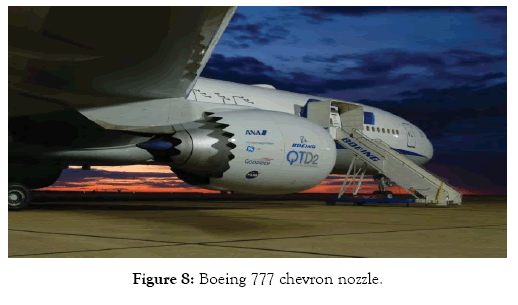
Figure 8: Boeing 777 chevron nozzle.
Micro-tab device
In 2010, Brian CK et al. conducted an investigation about a twodimensional numerical study, in the case of acoustic influence of micro-tab device on airframe noise mitigation. While the noise generated by leading-edge slat and trailing-edge flap rise as long as deflection angles are increasing, it is possible to reduce such high-lift noise by using reduced settings without sacrificing the aerodynamic performance during procedure, micro-tab device connected to the pressure side of the flap surface is intended as a means to this end. The resolution of the computation was selected so that the details of flow were captured in the critical noise generation area [61].
Flow-induced unsteady blade forces
Mathias Steger et al. found that additional sound field is the causes of the interaction between the rotor blades and these jets. The number of nozzles is as the same as the number of vanes in the stator due to create the same azimuthal modes as the stator. A slight decrease in overall sound power was made in a first optimization attempt, by shifting the azimuthal jet location relative to the stator vane. Most likely an optimization with respect to the axial position, nozzle diameter, and mass-flow rate of the jet will bring a significant reduction in the initial noise field from the rotorstator interaction [62].
Under certain conditions, this secondary sound field may offset the main sound field as was shown empirically for a low-speed fan by Schulz et al. [63] and numerically by Ashcroft and Schulz [64]. This method is now applied numerically to the fan of an aero engine with the objective to show that ANC is possible and to find the optimum position for the required flow rate and nozzles.
Acoustic liners
Novel acoustic treatments and design of turbofan engine shape ducts to attenuate such noise are important for the noise reduction of modern aircraft engines. These designs usually rely on extensive experimental tests, which are very time consuming and expensive. Acoustic liners are common to reduce noise within the turbofan bypass duct, and it is common practice to consider the effect of liner configuration as a noise reduction measure.
One effective way of reducing aero-engine noise is to use acoustic liners [65–69]. Due to weight restrictions, Noise reduction by acoustic liners has become difficult to achieve. Optimization the shape of turbofan duct is an alternative technology which is being considered in recent years. A noise optimization and prediction system for turbofan inlet duct designs, is developed by Zheng et al. [70] With the integration of an in-house software suite of computational fluid dynamics (CFD) codes, and a commercial software suite of codes, into an in-house optimizer, Soft liner and geometry optimizations of an axi-symmetric intake are performed by Pan et al. [71-74]. McAleer et al. [75] investigated the influence of duct geometry on noise propagation, however, the bypass design stage receives less attention during the bypass design stage, due to the sophisticated models needed for this require larger computational times, making analyses on duct geometry less possible within an industrial timescale. Among different optimization techniques which are mentioned in the literature, recently the adjoint method has become one of the widely used techniques for solving a variety of steady and unsteady optimization problems. Rumpfkeil combined a discrete-adjoint Newton–Krylov algorithm with a hybrid Navier–Stokes (NS)/Fowcs Williams and Hawkings farfield noise for shape optimization of a trailing edge flow to control aerodynamic noise [76-78]. Cao et al. [79] investigated the acoustic shape optimization of a fan inlet in the frequency domain by using a discrete adjoint method with the wave equation governed by a simple Helmholtz equation without considering the influence of a mean flow.
Stanescu et al. [80] developed the work of the optimal designs for the shape of fan inlet within the framework of linearized full potential equation and its discrete adjoint formulation [81]. However, their work just involves one design variable and their acoustic models are simple (Figure 9).
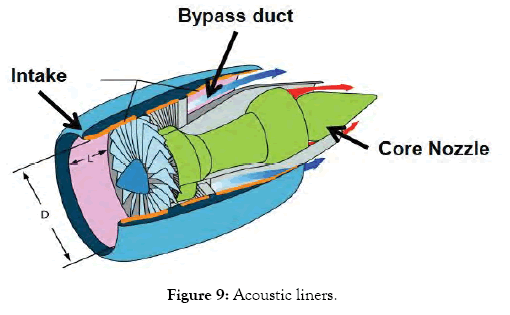
Figure 9: Acoustic liners.
Swept and leaned
Rotor-stator interaction is one of the mechanisms in noise generation in an aero engine; this includes periodic impingement of the rotor wake on the stator. As future designs are heading towards higher bypass ratio the interaction process is also expected to become more significant. Swept stators reduce fan noise by increasing the phase changes from hub-to-tip of the unsteady aerodynamics producing the sound and by increasing the effective distance from the fan to the stator vanes [82]. In general, the modern aircraft engines are designed using combination of the structural noise reduction technologies and passive methods which are assumed to install and absorbed the noise treatment in engine ducts [83,84]. Among the first group of noise reduction approaches in complying of the cutoff condition, choosing the optimal axial clearance between rotor and stator as on the one hand the increasing of axial clearance leads to noise mitigation and on the other hand to negative increasing of the engine weight. Recently scientific papers have been reported in which the configuration of fan design with the swept and leaned stator vanes were considered in terms of noise mitigation as compared to the conventional radial vanes [85]. Fan stator leaned and swept vanes are provided in order to weaken the mechanism of interaction between the stator vanes and the rotor wake.
One of the first published articles related to this subject shows that the stator vane angle equal to 45.2in the rotation reduces noise by 9 db [86]. Envia [87] describes general physical phenomena of noise mitigation in fans with swept-and-leaned stator vanes. Compared to radial stator vanes, the swept stator vanes provide an increased axial gap at the tip that is useful for noise mitigation. Additionally, the vane leaning leads to a great number of rotors wake-stator vanes span wise intersections. As a result, there is an additional decrease in the amplitude of sound wave.
Noise reduction technologies for future
What will be the challenges beyond 2020? In the last sections, various technologies presented, or to be applied, to conventional engine architectures, i.e., so-called “tube and wings” equipped with turbofans. However, the challenge to reduce fuel consumption is so great that new architectures are required. As mentioned before, Ultra High Bypass Ratio engines (UHBR) are being studied, but with difficult integration issues, because the fan diameter is even greater than it is currently used. With this option, noise reductions essentially require pushing for the same technologies more than the above technologies. In this case, the main machine noise, such as turbine noise, combustion noise or even compressor noise would need to be considered.
In addition to UHBR, another strategy could also be to keep on increasing BPR using the Open Rotor architecture (OR). The most critical issue is Noise, along with safety: while mostly tonal noise in the propeller plane radiated by single propellers. Actually, the radiated frequencies combine all of the possible linear combinations between the two blade passing frequencies and this spectrum is propagated in all directions. Currently there is ongoing research about facing this drawback and in order to lower this excessive noise several tricks are being investigated. From a programmatic perspective, Clean Sky research program is the main framework for such integrated research, by the end of the decade which will allow the engine manufacturer Snecma to produce a demonstrator.
This article has reviewed the current state of noises which are produced in aircrafts, and main mechanisms involved in aerodynamic noise reduction. This review paper has focused on various methods to reduce aircraft noise. Examples of these technologies have been presented, such as Active noise control and to calculate optimized shape body of duct or wings, Acoustic boundary control can reduce noises of engine and also to consider Landing gear noise can be efficient, the installation of chevrons mixer on exhaust nozzles, effects of higher by pass ratio, and Microtab device also were investigated. This is especially valuable, for instance, to evaluate the effect of a noise reduction device on the aircraft operating cost. A review of the main role technologies for airframe-, jet and fan-noise reduction and those currently under evaluation is also reported. While many scientific and technological elements have not been addressed, we believe that this work may be useful for a quick access to information in the field of aircraft noise reduction.
Citation: Sadeghian M, Bandpy MG (2020) Technologies for Aircraft Noise Reduction: Review Paper. J Aeronaut Aerospace Eng. 9:218. doi: 10.35248/2168-9792.20.9.219
Received: 06-Jan-2020 Accepted: 17-Jan-2020 Published: 24-Jan-2020 , DOI: 10.35248/2168- 9792.20.9.219
Copyright: © 2020 Sadeghian M, et al. This is an open access article distributed under the term of the Creative Commons Attribution License, which permits unrestricted use, distribution, and reproduction in any medium, provided the original work is properly cited.